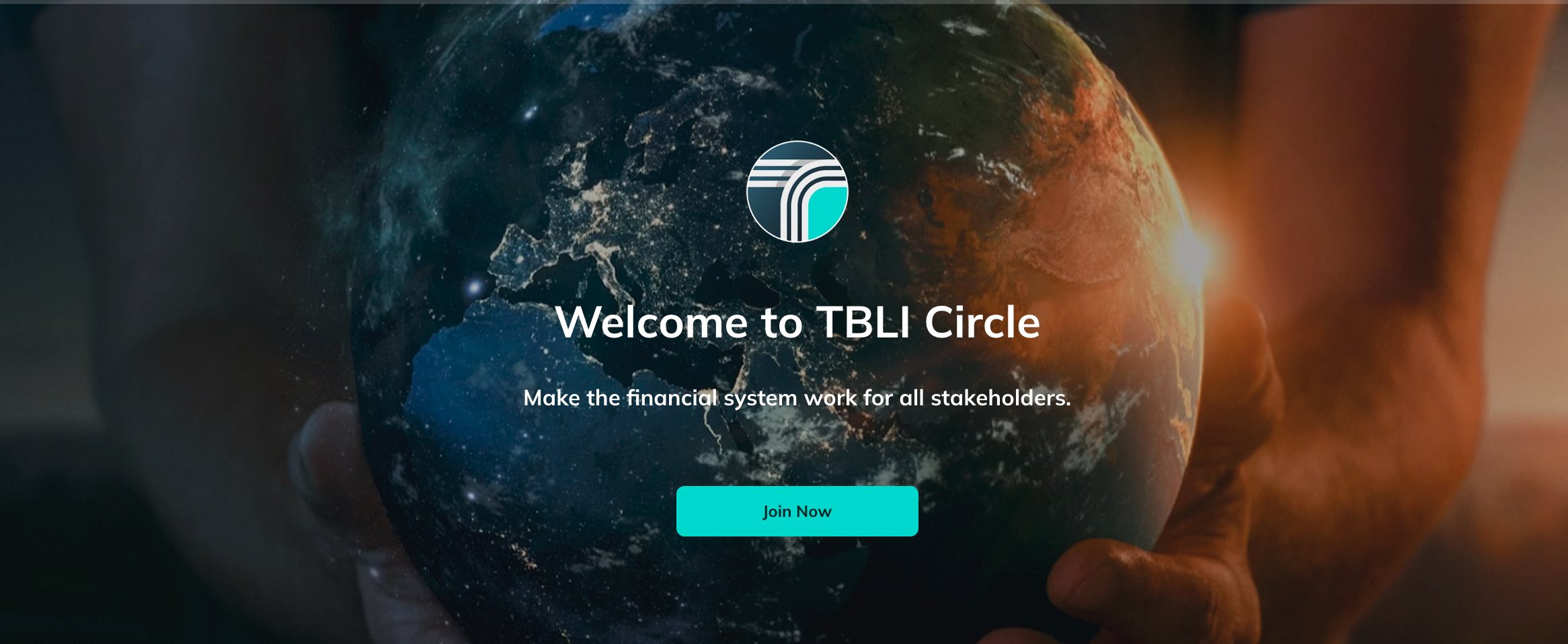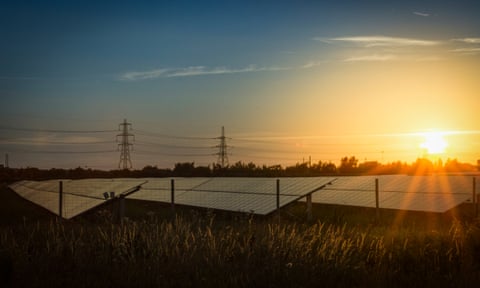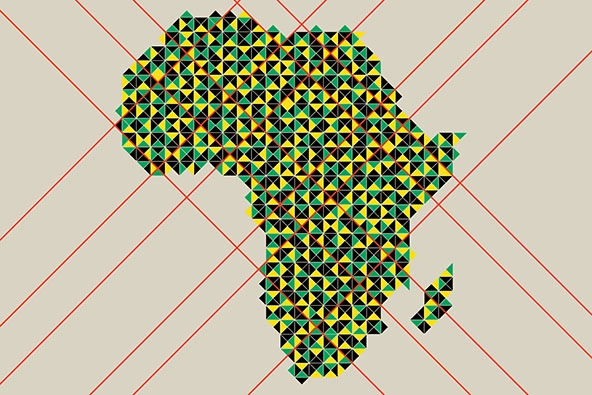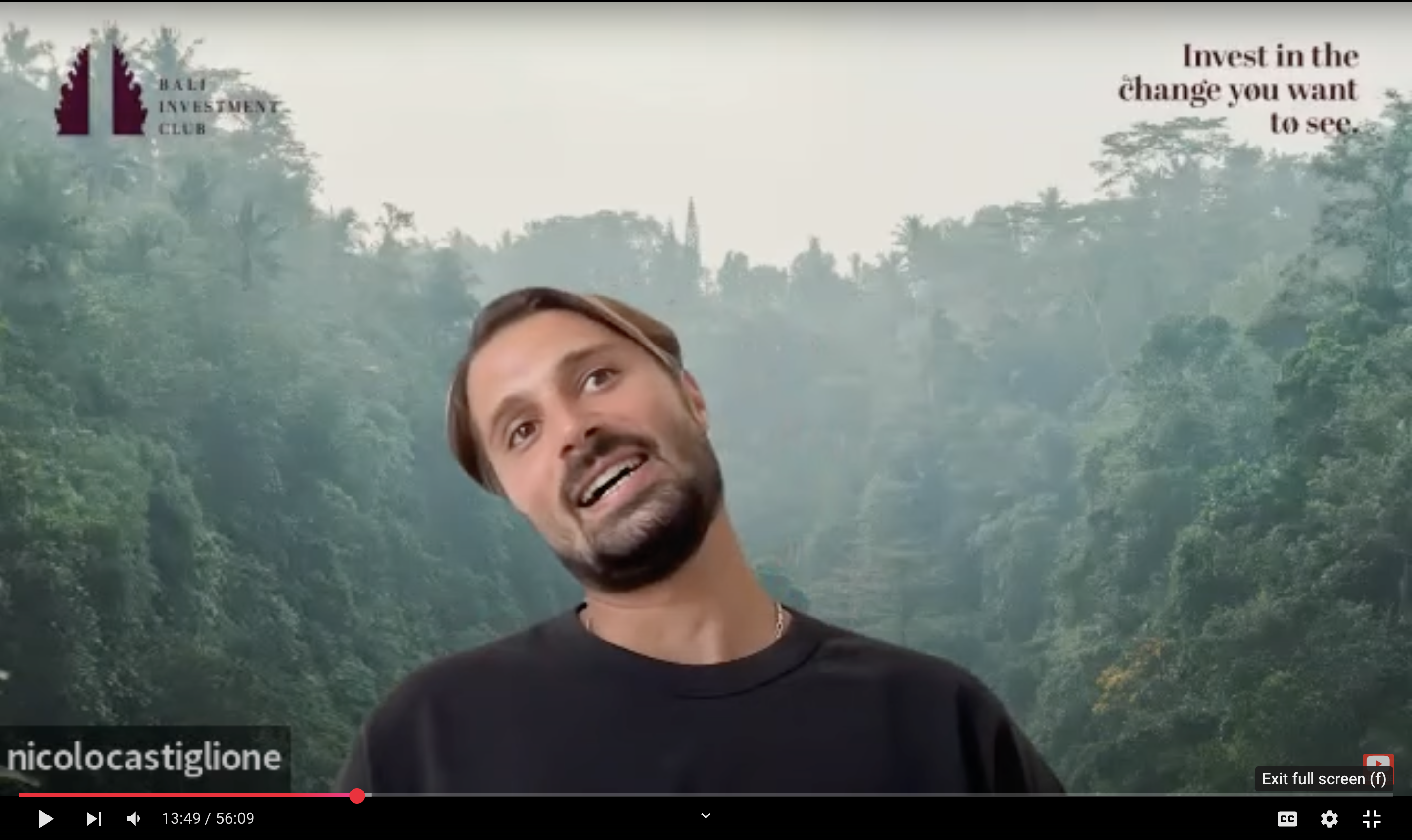
Your weekly guide to Sustainable Investment
TBLI Capital Connect
Your Gateway to Mission-Aligned Investors
Why TBLI Capital Connect?
✅ Access to a curated network of high-net-worth investors and venture capitalists
✅ Tailored matchmaking to align you with the right funding partners
✅ Streamlined process to fast-track your fundraising goals
✅ Different tiers of service, offering you the most suitable service according to your budget.
More details here
Would you like to book a call to discuss in detail? click here
TBLI Virtual Mixers
Join the TBLI Virtual Mixer every last friday of the month at 16:00 CET.
Connect with mission-driven investors, entrepreneurs, and changemakers creating real value.
This isn’t just another virtual event. It’s where the right people come together to create lasting change.
Will you be in the room?
🔹 Spots are limited—secure yours now.
Spotlight Interview
How Nicolo Castiglione is creating a startup impact ecosystem for entrepreneurs in Indonesia
In this edition of our spotlight series, we speak with Nicolo Castiglione, founder of Archipelago VC, an early-stage investment firm focused on unlocking the potential of Indonesia’s startup ecosystem. Nicolo shares his journey into impact investing, what makes Indonesia a uniquely promising market, and how Archipelago is backing the next generation of entrepreneurs building scalable, meaningful solutions across the archipelago.
Join TBLI Circle and expand your Impact network

Step into a community of purpose-driven professionals transforming finance for a sustainable future. At TBLI Circle, you’ll connect with authentic leaders, discover breakthrough opportunities, and gain insights that drive real impact. Expand your network, elevate your influence, and accelerate your journey in ESG and impact investing. Don’t just talk about change—be the change.
Expand your network, elevate your influence, and accelerate your journey in ESG and impact investing. Don’t just talk about change—be the change.
Clean energy powered 40% of global electricity in 2024, report finds

Thinktank says solar has been fastest-growing energy source for last 20 years, but remains dwarfed by hydro power
The world used clean power sources to meet more than 40% of its electricity demand last year for the first time since the 1940s, figures show.
A report by the energy thinktank Ember said the milestone was powered by a boom in solar power capacity, which has doubled in the last three years.
The report found that solar farms had been the world’s fastest-growing source of energy for the last 20 consecutive years.
Phil MacDonald, Ember’s managing director, said: “Solar power has become the engine of the global energy transition. Paired with battery storage, solar is set to be an unstoppable force. As the fastest-growing and largest source of new electricity, it is critical in meeting the world’s ever-increasing demand for electricity.”
Overall, solar power remains a relatively small part of the global energy system. It made up almost 7% of the world’s electricity last year, according to Ember, while wind power made up just over 8% of the global power system.
The fast-growing technologies remain dwarfed by hydro power, which has remained relatively steady in recent years, and made up 14% of the world’s electricity in 2024.
Hydro power is one of the modern world’s oldest renewable energy technologies, and made up a large proportion of global electricity in the 1940s – when the power system was about 50 times smaller than it is today.
The continuing growth of solar means clean power – including nuclear and bioenergy – is on track to expand faster than the world’s overall electricity demand, according to Ember. This should mean fossil fuels beginning to be squeezed out of the global power system.
Ember had previously predicted that 2023 would be the year in which emissions from electricity reached a peak, after a plateau in the first half of the year.
Climate experts hoped then that emissions would begin to fall, but a series of heatwaves across the globe ignited a surge in demand for electricity to power air conditioning and refrigeration systems, which caused fuel electricity to grow by 1.4% that year.
The report, which accounted for 93% of the global electricity market across 88 countries, found that the surge in demand pushed emissions from the global power sector up by 1.6% to an all-time high last year.
MacDonald said heatwaves were unlikely to ignite a similar demand surge in the year ahead – but the increasing use of electricity to power artificial intelligence, datacentres, electric vehicles and heat pumps was expected to play a bigger role in the world’s appetite for electricity.
Combined, these technologies accounted for a 0.7% increase in global electricity demand in 2024, double what they contributed five years ago, the report found.
“The world is watching how technologies like AI and EVs will drive electricity demand,” MacDonald said. “It’s clear that booming solar and wind are comfortably set to deliver, and those expecting fossil fuel generation to keep rising will be disappointed.”
Source
Introducing Arketa Institute for Post-Growth Finance

Each of the founders of Arketa Institute have taken a different path through a career in finance. However, we all ended up in the same place. We each understand that finance and economics as we know them today aren't fit for purpose, and we are committed to–and energized by–the idea of building something better.
The “Predicament”
The dominant economic system is doing just that: dominating all of us. It’s incentivising us to make harmful decisions and turn everything that we have–natural resources, human resources, and effectively all of life–into products and services that can be sold at a profit. Finance as an industry is all too often tasked with pushing those returns to be as high as they can be and then delivering them directly to the people that already have the most money to spare (investors).
This doesn’t seem like the economy we would have wanted for ourselves if given the choice.
Still, as things stand now, it operates with mind-boggling efficiency. And it’s threatening the wellbeing of all humanity. Instead of balancing our planetary budget to make sure the resources we have available can cover our total needs, we’re taking on heaps of environmental debt, and for what? We’re way over budget, and the payments are coming due.
We see this clearly in the breaching of planetary boundaries, and in the disregard for scientific consensus warning us that our way of life is compromising life itself.
We have a system so set on economic growth that it fails to see that the pursuit of GDP and financial returns at all costs is pushing the natural systems of Earth past the point where they can support our lives, much less our current way of living.
Nothing is meant to grow forever. Trees don’t grow infinitely, animal populations in nature usually stabilize (or overwhelm their environment and crash), and we as human beings stop growing physically after we have lived only about twenty percent of our lives. We then spend the rest of our lives growing in other ways, and maintaining our physical form as best we can.
Because of the real limits on economic growth, we should think about our economies the same way. Once we get to a certain level of development, we need to focus on maintaining the wellbeing of our societies, not on economic growth that is ultimately self-destructive.
The Backstory of GDP
For most of human history, the growth of an economy was not considered an adequate measure of human success. That changed nearly one-hundred years ago when an American economist, Simon Kuznets, was charged with creating a way to better track the performance of the economy in the mid-1930s. He came up with Gross Domestic Product (GDP) which simply adds up the market value of all products and services produced in an economy during a given period.
But even Kuznets himself warned that GDP should not be used to judge the total economic prosperity of a country. GDP only measures economic output, ignoring all the factors that went into that economic output and erasing large swaths of activity that make that output possible.
If you bring your child to daycare, it counts towards GDP, but when your child is cared for by friends and family, it doesn’t. Turning trees into paper and lumber counts towards GDP, but leaving them as a forest doesn’t. Losing your house and everything in it in a natural disaster? Great for GDP, because all of those things have to be purchased and built again. But obviously not so good for you…
Currently, GDP and the limited activities and exchanges it estimates are a large part of how we measure our success as a society. Politicians promise growth. CEOs get fired if they don’t deliver growth. If investors or their intermediaries don’t realize growth in the form of returns, they’re considered unsuccessful or as breaching fiduciary duty, and liable to lose their jobs.
But pursuing those growth metrics has pushed our planetary boundaries–which measure the health of our life support system–into the red. The science shows that the natural world that supports us is crumbling and will turn from our defender to our destroyer if we continue on our unsustainable path.
Acknowledging this reality is still the exception in the world of finance. And for good reason. Accepting it goes against the logic of how our economies are currently organized, how our nations measure their success, and quite possibly our very identity.
Breaking down, then building up: What this process looked like for us
Recognizing the role of economic growth in natural and social degradation, and finance’s role in perpetuating our dependence on economic growth, is not easy when your life so far has been built around exactly that.
We didn’t aspire to pursue this new path, but after weighing the preponderance of the evidence, we didn’t see any other choice. None of the other options were sufficient.
Sustainable finance, impact investing, blended finance and other attempts by our industry to address these issues all fell short of the actions that needed to be taken to address the environmental, social and economic problems we saw.
When each of us was eventually confronted with this, we felt overwhelmed, alone, and full of questions. Can I still do my job? Is my whole career irrelevant? If I start talking about this publicly, will my colleagues reject me? Is this totally crazy?
These ideas are so different from the economics we learned in university and the practices we’ve been applying our whole careers that we hesitated to even speak that out loud.
We felt afraid–especially for our children–and guilty about the roles we’ve played within this system so far. It can be terrifying, but doing nothing was not an option.
As we searched for answers, we slowly but surely discovered others with the same concerns as us. We found many of these people among those who studied and practiced ecological economics.
Ecological economics reminds us that “the economy” lies within society, and that both the economy and society sit within and depend upon our environment. It emphasizes the dependency of our economy on the natural world, making clear the damage we do to ourselves by damaging our environment. Ecological economics recognizes that an economy that grows forever simply is not possible on a finite planet, and it shifts the focus instead to ask what the optimal scale of the economy might be.
Read full article
Government Urged to Back Basic Income for Farmers

A wave of unease is sweeping through England’s farming community as the government freezes a key environmental subsidy scheme—just as many land managers were gearing up to make vital changes to restore biodiversity and curb agricultural emissions.
Environment Secretary Steve Reed has put the Sustainable Farming Incentive (SFI)—a flagship program designed to reward farmers for integrating nature into their land management practices—on pause pending a comprehensive review slated for June’s spending summit. But it's not just a temporary delay that has alarm bells ringing. Reed is reportedly considering excluding wealthier, higher-earning farmers from accessing future rounds of the scheme altogether.
The SFI, introduced post-Brexit to replace the EU’s Common Agricultural Policy, was intended to redefine agricultural support, shifting from simply rewarding land ownership to incentivizing the protection of public goods—healthy soil, clean air, biodiversity, and carbon reduction. But now, both the program's scope and budget are under scrutiny.
This policy pivot has created uncertainty across a sector grappling with climate volatility, rising operational costs, and shifting regulatory sands. Suppose prosperous farms are cut off from participation. In that case, the government risks undermining its environmental ambitions—especially given that 70% of England’s landscape is agricultural land. Without financial backing, efforts to rewild sections of farmland, restore wetlands, plant native hedgerows, or establish wildflower corridors may stall.
For farmers like Amelia Greenway, aged 24, the policy shift is more than a political maneuver—it’s a gut punch. Greenway manages 365 hectares (900 acres) of mixed grazing pasture for native pigs and cattle on the Killerton Estate, a National Trust property in Devon. She had been applying for £94,000 in SFI payments when the government pulled the plug, leaving her plans and budget in limbo.
Similarly, Anthony Curwen, 63, who oversees 1,012 hectares (2,500 acres) of arable farmland at Quex Park in Kent, had just completed his SFI application when the scheme was frozen. With fields producing wheat, oilseed rape, oats, beans, maize, and potatoes, Curwen had hoped to weave environmental stewardship into the farm's day-to-day operations. Like many others, he’s facing a silent inbox and no guidance on what comes next.
For many in the agricultural world, this latest development feels like a betrayal of climate promises and practical cooperation. The government's signal that high-earning farms may be barred from accessing restoration funding—based not on land use but profit margins—introduces a troubling precedent. Are we prioritizing equity or quietly downsizing our climate ambitions?
Nature restoration is not a luxury—it’s a necessity. These are not vanity projects, from carbon sequestration in hedgerows to flood mitigation through pond systems. They’re climate infrastructure. They also require sustained, strategic investment, not abrupt freezes and exclusionary reform.
Read full article
Head of African Bank Warns of “Carbon Grabs” by Foreign Firms

Akinwumi Adesina, outgoing president of the African Development Bank, is warning that foreign firms are underpaying for carbon credits from African forests.
“We used to have land grabs. Now we are having carbon grabs,” he told The Financial Times this week, doubling down on recent assertions that Africa is being “short-changed” on carbon removal.
In remarks at last year’s U.N. climate summit in Azerbaijan, Adesina noted that in Europe, the price of carbon can reach $200 a ton but in Africa can sink as low as $3 a ton. Some African countries, he said, are giving up huge swaths of forest for carbon removal and, in the process, losing sovereignty over their land.
The total value of carbon drawn down by African lands was $66 billion in 2022, according to a report from the African Development Bank. The report concluded that Africa is “nature rich and cash poor,” and that a “proper valuation” of its natural wealth would allow countries to access more capital.
“It is time for Africa’s green wealth to be properly measured,” Adesina said in his U.N. remarks. “It is time for Africa to be green rich and cash rich.”
Source
How Funder Collaboratives Are Supporting Proximate Organizations in Africa

By Atti Worku, Degan Ali & David Bowermaster - ssir.org
An interview with two collaborative fund leaders about what differentiates Africa’s collaborative funding movement from other regions, and what other funders can learn from their focus on funding organizations close to the communities they are trying to help.
Philanthropic collaboratives are growing in popularity in Africa and share many similarities with their global peers, but they also have their own distinguishing traits.
For one thing, African collaboratives tend to be underfunded relative to collaboratives in other parts of the world. Though they have a strong record of impact and capacity to accomplish more with higher levels of support, 60 percent of African collaborations have annual budgets below $10 million, while 70 percent of global collaborations have annual budgets above $10 million.
For another, African collaboratives are more likely than their global peers to establish independent entities to implement their programs. This keeps their brands front and center and eliminates potential funder recognition battles.
In addition, 6 out of 10 African collaboratives work only within the countries where they are located, reflecting both the diversity in social, economic, and political environments within the continent and the pragmatic challenges of transferring money across borders.
This data comes from a 2024 report from The Bridgespan Group, which found a “robust and complex” trend of greater philanthropic collaboration in Africa. The report identified 131 philanthropic collaborations in Africa, of which 73 are focused solely on the continent. (The rest worked in multiple regions.) Nearly 80 percent of the African collaborations were created since 2010.
What can other funders learn from Africa’s collaborative movement, particularly its focus on funding organizations close or “proximate” to the communities they are trying to help? The following conversation between David Bowermaster, founder of Fireside Strategy, and leaders of two collaborative funds focused on Africa—Atti Worku, a native of Ethiopia and co-CEO of African Collaborative (formerly the African Visionary Fund) and Degan Ali of Somalia, executive director of Adeso and creator of the Proximate Fund—articulates the power of this approach.
David Bowermaster: African Collaborative was created in 2020 with a mission to increase the share of international funding that flows directly to locally led organizations on the continent. It is one of several collaboratives that have emerged as powerful and popular mechanisms—for African and non-African funders alike—to transfer more money and decision-making to organizations close to communities and thus closer to solutions. What are the benefits of this approach?
Atti Worku: One benefit is agility and resilience in times of rapid change, which are becoming more rule than exception. When the US government abruptly halted $8 billion of aid to Africa in early 2025, I received lots of questions from funders wondering how to respond. It took me back to the beginnings of the COVID-19 pandemic. People were asking a lot of the same questions. “The world is falling apart, what can I do?” In both instances, my advice was the same: Support proximate organizations that work each day to meet the needs of their communities, and trust they know best how to deploy the resources.
Read full interview
https://mail.tbligroup.com/emailapp/index.php/lists/cm138dw4qa9f1/unsubscribe
